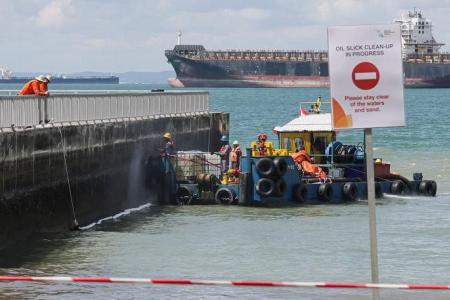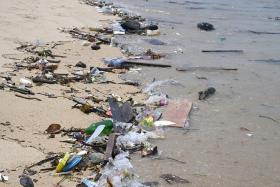First hawksbill turtle nest found at ECP after oil spill
A nest of eggs from the critically endangered hawksbill turtle has been found at East Coast Park, the first since the 400-tonne oil spill on June 14 that marred Singapore’s shorelines.
With the ongoing turtle nesting season, which lasts from around May to October, researchers are hoping to study the impact of the oil spill on this year’s turtle hatchlings and eggs.
The National Parks Board (NParks) confirmed that it was alerted to the nest on June 23, and has secured the nest with barriers to protect the eggs from predators.
“We will continue to monitor the nest to assess the nest conditions and determine an estimated hatch date,” said Dr Karenne Tun, director at NParks’ National Biodiversity Centre.
The hawksbill turtle is one of two species of marine turtles that can be found in Singapore waters, the other being the green turtle.
Female turtles come to the sandy beaches of East Coast Park and the Southern Islands to lay eggs during the yearly nesting season.
A hawksbill turtle typically lays more than 100 eggs in each nest. The eggs incubate for about 55 days and the hatchlings emerge in two batches. They instinctively head for the open sea after.
Mr Bernard Seah, a wildlife photographer and conservationist, said that it is unlikely that the oil spill would have any immediate impact on the nest.
Part of the reason is that the bulk of the thick oil slicks had been cleaned off the beaches before the nest was found.
“Also, hawksbill turtles typically nest on the high shore outside the intertidal zone, which was the area affected by the oil spill,” said Mr Seah.
He added that there is no need to move the nest to a hatchery.
The Republic has a turtle hatchery at Sisters’ Island Marine Park, where nests found at unsuitable sites – like places with high human footfall – are moved to.
“The eggs are hypersensitive to movement. Any movement after the early stages – which is only about a couple hours to a few weeks – after the egg is laid, you could risk killing the embryo growing inside,” said Mr Seah.
He is more concerned about the mother turtle, who could have swum through thinner oil sheens still present in the water.
Assistant Professor Kim Hie Lim, of the Asian School of the Environment and Singapore Centre for Environmental Life Sciences Engineering (SCELSE), who has been studying nesting sea turtles in Singapore since 2019, is hoping to learn more about the oil spill’s impact on this year’s hatchlings and eggs.
To do so, she will be collecting water, sand, and unhatched egg samples.
“Oil spills can severely impact the survival rate of hatchlings on affected beaches. According to previous studies on development and survival of marine turtles, aggregated oil slicks can physically impair and trap hatchlings,” said Prof Kim.
“Even smaller oil slicks can have a detrimental effect. Both hatchlings and adults may unintentionally ingest or inhale toxins from these spills, which can be harmful. Singapore is home to sea turtles at various life stages, and sea turtles are vulnerable to oil spills at all life stages,” she added.
An NParks spokesman said members of the public should contact the agency’s helpline on 1800-471-7300 if they encounter a nesting turtle on Singapore’s shores.
They should also keep a distance and refrain from shining lights on the sighted turtles. Touching the turtle may scare or provoke it. Similarly, one should not handle the eggs, as that might damage them.
The authorities have warned that the impact of the oil spill on marine and coastal ecosystems may show up only weeks or months later.
So far, oil slicks have been spotted at sensitive habitats in Labrador Nature Reserve, on Sentosa and parts of the Southern Islands in the week after the incident.
To plan for ecological recovery, the nature community and scientists will continue to monitor marine biodiversity and do impact assessments.
The scientific community has started surveys of the Southern Islands, Labrador Nature Reserve, and Sentosa’s Serapong and Tanjong Rimau for the authorities to better understand the longer-term impacts of the oil spill on biodiversity.
Associate Professor Yann Felix Boucher, principal investigator at SCELSE, said that the research centre will be studying microbes in seawater at sites like St John’s Island.
Since June 16, the research team has been collecting water and sediment samples around three sites at St John’s Island every three days. Team members will be analysing the water samples for hydrocarbons – which are organic compounds found in crude oil – to determine how they impact microbial activity and diversity.
“Microbes in the water would recycle elements like carbon and nitrogen which are necessary for the health of the ecosystem.”
“If some members of the chain – as part of this ecosystem – die as a result of the oil spill, it can really change the whole dynamic of the ecosystem and destabilise the whole thing,” said Prof Boucher, who added that it will take some time for the effects to be seen.
Get The New Paper on your phone with the free TNP app. Download from the Apple App Store or Google Play Store now


